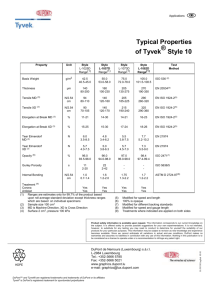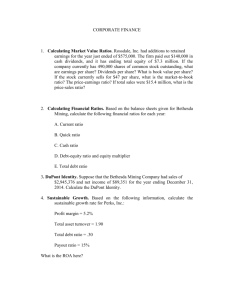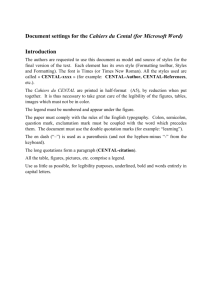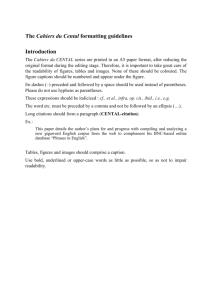Performance Improvements in PV Modules Using Ionomer Encapsulants Mark Jacobson
advertisement
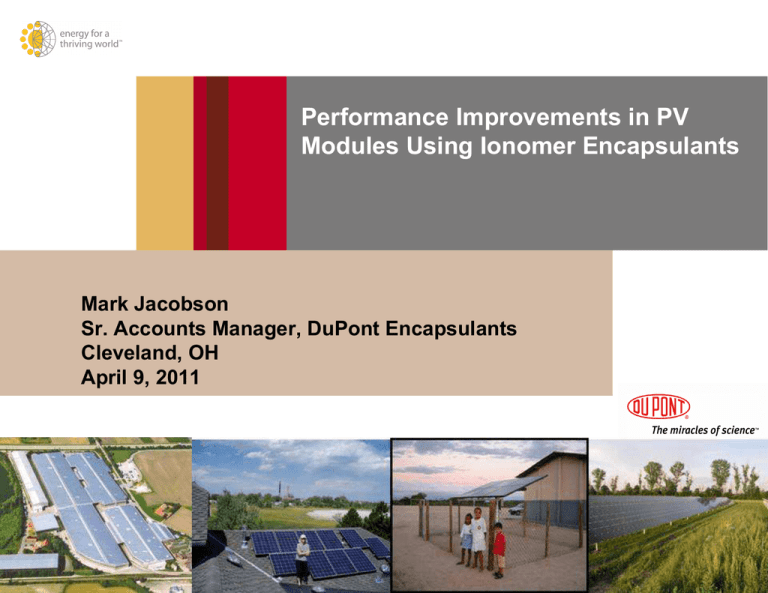
Performance Improvements in PV Modules Using Ionomer Encapsulants Mark Jacobson Sr. Accounts Manager, DuPont Encapsulants Cleveland, OH April 9, 2011 2 Agenda •Encapsulant requirements •Failure modes •Moisture Ingress and WLC •NREL results •Strength enhancement •Other benefits •DuPont encapsulant offerings DuPont Photovoltaic Solutions © DuPont 3 Examples of Required Encapsulant Attributes Encapsulant Requirements for Thin Film Glass/ Glass Modules Low System Cost Durability • • • 25 years no delamination Cell efficiency over life of module Meets operating temperature requirements Compatibility with Top Coat Material Low Moisture Permeability Protect the Cell from Corrosion High Resistivity = Low Current Leakage • • Safety requirement Important in maintaining cell efficiency over lifetime Ease of Processing with High Thru-put • • Autoclave Vacuum laminator No Lamination Defects • No bubbles Ease of Handling DuPont Photovoltaic Solutions © DuPont 4 The Importance of Encapsulants in Module Design Common Causes of failure in Thin Film Modules • Failure occurs predominantly in the damp heat test (85C/85%RH, 1000hrs) • The cause of failure is typically due to excessive wet current leakage after aging (wet resistance) • Current leakage is most often dependent on module package integrity (encapsulant, J-box, front/back cover) Tamizhmani, G., et.al.”Failure Analysis of Module Design Qualification Testing – III” 35th IEEE PVSC Proceedings, 2010, Honolulu, Hawaii DuPont Photovoltaic Solutions © DuPont 5 Minimal Wet Current Leakage After Extended Aging Wet Current Leakage after Damp Heat Testing Electrical Resistance (M Ohms) 400 Thin Film Glass-Glass module* with DuPont™ PV5400 • Excellent initial resistance 350 300 • Low resistance decline after aging 250 200 • Easy pass in IEC 61646 damp heat test 150 Minimum resistance required to pass IEC 61646 standard after 1000hrs damp heat 100 50 0 0 500 1000 2000 o Hours Damp Heat (85 C / 85% RH) * No edge sealing (tape or caulk) used, frameless DuPont Photovoltaic Solutions © DuPont 3000 • No edge sealing or frame required 6 The Benefits of DuPont™ PV5400 Ionomer Low Moisture Ingress Glass laminate moisture ingress after 2000hr DH 0.45 Diffusion coefficient is 4-6x less than EVA encapsulant Equilibrium Moisture level is half of EVA encapsulants % Moisture 0.40 0.35 0.30 EVA 0.25 • Provides excellent protection and insulation for electronic components over the module lifetime DuPont™ PV 5400 Ionomer 0.20 0.15 0.10 0.05 0.00 0 2 4 6 8 10 12 14 16 18 Distance from Edge (cm) High Resistivity Polymer Encapsulant Material Surface Resistivity DuPont™ PV5400 Ionomer 1016 Cross-linked EVA 1014 DuPont Photovoltaic Solutions ASTM D257 23C, 50%RH © DuPont 20 • Introduces the possibility of a stable module without edge seal compounds • Enables low cost frameless module design 7 Why Ionomer? Performance in Independent Studies “Samples with a quartz face or soda-lime glass in combination with an ionomer encapsulant did not degrade.” (unlike glass/SiO2 barrier or EVA) Fig. 10. Loss of pseudo fill factor (FF) and open-circuit voltage (Voc) after 140 h at 45°C/30% RH with –1000 V bias applied to the active layer for five mini module constructions (plus controls). “For the hydrocarbon based materials, only the ionomer is demonstrating UV stability for 10X CPV applications” Figure 8. QE- and solar-weighted transmission for a thermoplastic polyurethane (TPU), an ionomer, and polyvinyl butyral (PVB) as a function of exposure to 42 UV suns. The changes in YI for the ionomer, PVB and TPU correlate well with changes in optical transmission. M.D. Kempe et. al., NREL (US), “Accelerated StressTesting of P.Hacke et. al., NREL (US), ECN (NL), “Characterization of Multi-Crystalline Hydrocarbon-based Encapsulants for Medium Concentration CPV Silicon modules with System Bias Voltage Applied in Damp Heat”, 25th EU Applications”, 34th IEEE PVSC, 2009, Philadelphia DuPont Photovoltaic Solutions © DuPont PVSEC, 2010, Valencia, 8 High Modulus Enables Low Cost Mounting Finite Element Analysis of Module Mechanical Properties 3 “Layers” for Panel • Glass-Encapsulant-Glass Four clamp support system • Aluminum clamps with EPDM gaskets • Clamps fixed at center points 4 Clamp Module: +2.4 kPa 1 hr 22 C 3.2 mm Glass / t mm Encapsulant / 3.2 mm Glass Maximum Principal Glass Stress (MPa) 50 • Glass stress minimally impacted by encapsulant thickness 45 65% Breakage Probability 40 PV 5400: 150 mm Clamp 35 PV 5400: 70 mm Clamp PVB: 150 mm Clamp 30 • Glass stress is sensitive to clamp size PVB: 70 mm Clamp 25 3% Breakage Probability 20 0.2 0.4 0.6 0.8 1 Encapsulant Thickness, t (mm) DuPont Photovoltaic Solutions © DuPont • Ionomer laminate with 150 mm clamp strong enough when used with all annealed glass 9 Other Benefits of Unique Ionomer Chemistry Ionomer Chemical Structure COOH COO H • No potential for acetic acid formation – minimizes possibility of corrosion COO H COOH COOH Acid-functionalized hydrocarbon copolymer Ion (X) exchanged with Na, Zn, Mg • Inherent adhesion to glass (no adhesion promoters needed) • Excellent adhesion to a variety of metals (such as Al, chrome and Zn) • Excellent adhesion retention due to low moisture ingress COOX COOH • Melt temperature and flow enable fast lamination on existing vacuum laminators COOX++ -OOC COOH ++X OOC COOIonomer clusters form pseudocross-links DuPont Photovoltaic Solutions • Easy handling, no need to refrigerate or interleaf sheeting © DuPont 10 DuPont now Offers Five Encapsulant solutions • DuPontTM PV5200 series (PVB sheet) • DuPontTM PV5300 series (High Clarity Ionomer sheet) • DuPontTM PV5400 series (Low Moisture Ionomer sheet) • DuPont™ PV8600 series (Modified Ionomer sheet) • DuPontTM Elvax® PV1000 series (EVA Resin) - sold into PV market for 30 years Continuous pipeline of innovative encapsulants DuPont Photovoltaic Solutions © DuPont Developed by DuPont-Mitsui Developed by the leader in the glass industry with over 60 years of innovation 11 Copyright © 2012 DuPont or its affiliates. All rights reserved. The DuPont Oval Logo, DuPont™, The miracles of science™ and all products denoted with ™ or ® are registered trademarks or trademarks of E. I. du Pont de Nemours and Company or its affiliates. DuPont Photovoltaic Solutions © DuPont 12 DuPont Photovoltaic Solutions © DuPont


